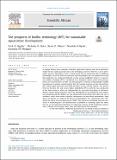Acceptability, adherence, and clinical outcomes, of amoxicillin dispersible tablets versus oral suspension in treatment of children aged 2–59 Months with pneumonia, Kenya: A cluster randomized controlled trial
Publication Date
2020Author
Linet M.Angwa, CollinsOuma, PeterOkoth, Rachel Nyamaid, Nyawira G.Kamaue,Kennedy Mutaif, Maricianah A. Onono
Metadata
Show full item recordAbstract/
Amoxicillin dispersible tablet (DT) is now recommended by the WHO as a first-line drug for the treatment of pneumonia in children below 5 years. The study aim was to compare acceptability, adherence and clinical outcome of amoxicillin DT and amoxicillin oral suspension (OS) in the treatment of children aged 2–59 months with pneumonia in Kenya. We conducted a two-arm cluster randomized controlled trial and utilized quantitative methods. The community unit was the unit of randomization. Children aged 2–59 months with pneumonia were enrolled and treated with either amoxicillin DT or OS. Acceptability was defined as the perception of taste of medication as the same or better compared to other medicines and expression of willingness of caregivers to use DT/OS in future, adherence was measured based on the dose, frequency, and duration of treatment, and clinical outcome as complete resolution of symptoms without change of antibiotic treatment. Equivalence was defined as a difference of ≤8% between study arms. We found high levels of acceptability among both DT (93.9%) and OS (96.1%) arms (difference 2.3%, 90% CI -2.6-7.3). The objective measure of adherence on day four and the overall objective measure were significantly higher among children on DT compared to children on OS (88.7% vs. 41.5% (difference 47.2%, 90% CI 31.0–63.3) & 83.5% vs. 39% (difference 44.5%, 90% CI 27.9–60.9), respectively). Cure rates were high in both arms (DT (99.5%), OS (98.1%), difference 1.4%, 90% CI -0.2-3.2). There is reported better adherence to Amoxicillin DT compared to OS and equivalence in acceptability and clinical outcomes.

